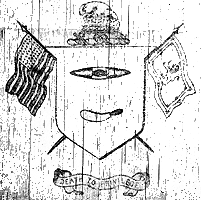
Andrew Carnegie
Alfred
Aristotle
Charlemagne
Dante
Franklin
Hegel
Kant
Laplace
Lincoln
McKinley
Milton
Newton
Plato
Socrates
Virgil
Washington
Carnegie Building
|

 |
- During his lifetime, Andrew Carnegie acquired a coat of arms. This was definitely not given to an ancestor for his courage in battle; Carnegie devised his own coat of arms. He created his own coat of arms and commissioned an artist to paint it on one of the library walls in his New York City mansion. The center shield contains a weaver’s shuttle, as his father, William Carnegie, was a weaver. It also contains a shoemaker’s knife because one of his recent ancestors worked as a shoemaker. He has said he does not intend to ignore his humble beginnings and wishes to recognize these men as his forebears. The coat’s crest contains a reversed crown topped by the cap of liberty. On the sides of the shield are the American and Scottish flags, and the motto is “Death to Privilege.”
|
- In spite of his philanthropic activities, Andrew Carnegie was not
known as a friend of labor. Margaret Byington, author of a study of
steel-town life, wrote of her interviews with Carnegie's workers,
"Many a man said to me, 'We'd rather they hadn't cut our wages
and let us spend the money for ourselves. What use has a man who works
twelve hours a day for a library, anyway?'" (Margaret Byington,
Homestead: The Households of Mill Town).
- During Carnegie’s many years in business, the various Carnegie
companies were extremely prosperous. They were prosperous to such
an extent that in 1901, he sold his steel holdings to a group of New
York-based investment bankers led by J.P. Morgan for $250 million.
The buyout, which was negotiated in secret by Charles M. Schwab (no
relation to Charles Schwab of the brokerage house) was the largest
such industrial takeover in the United States at the time. This steel
company was incorporated into J.P. Morgan’s U.S. Steel Corporation,
and Andrew Carnegie retired from business.
- In 1880, at age 45, Andrew Carnegie began courting Louise Whitfield,
age 23. Carnegie’s mother was the primary obstacle
to the relationship. Nearly 70, Margaret Carnegie was used to her
adoring son’s complete attention; they shared a suite at New
York’s Windsor Hotel, and she accompanied him everywhere –
even to business meetings! Some have hinted that she made Carnegie
promise to remain a bachelor during her lifetime. Only after his mother's death in 1886 were Andrew and Louise finally married. They named their only child after Margaret.
Carnegie was the first to acknowledge what a huge role his mother
played in his life. "Perhaps some day I may be able to tell the
world something of this heroine, but I doubt it," Carnegie wrote
in his autobiography. "I feel her to be sacred to myself and
not for others to know. None could ever really know her--I alone did
that. After my father's early death she was all my own."
- By the time he died in Lenox, Massachusetts, Carnegie had given
away $350,695,653. At his death, the last $30,000,000 was also given
away to foundations, charities and pensioners.
- "Put all your eggs in one basket and then watch that basket."
One of Andrew Carnegie's business maxims later borrowed by Mark Twain.
back

|

